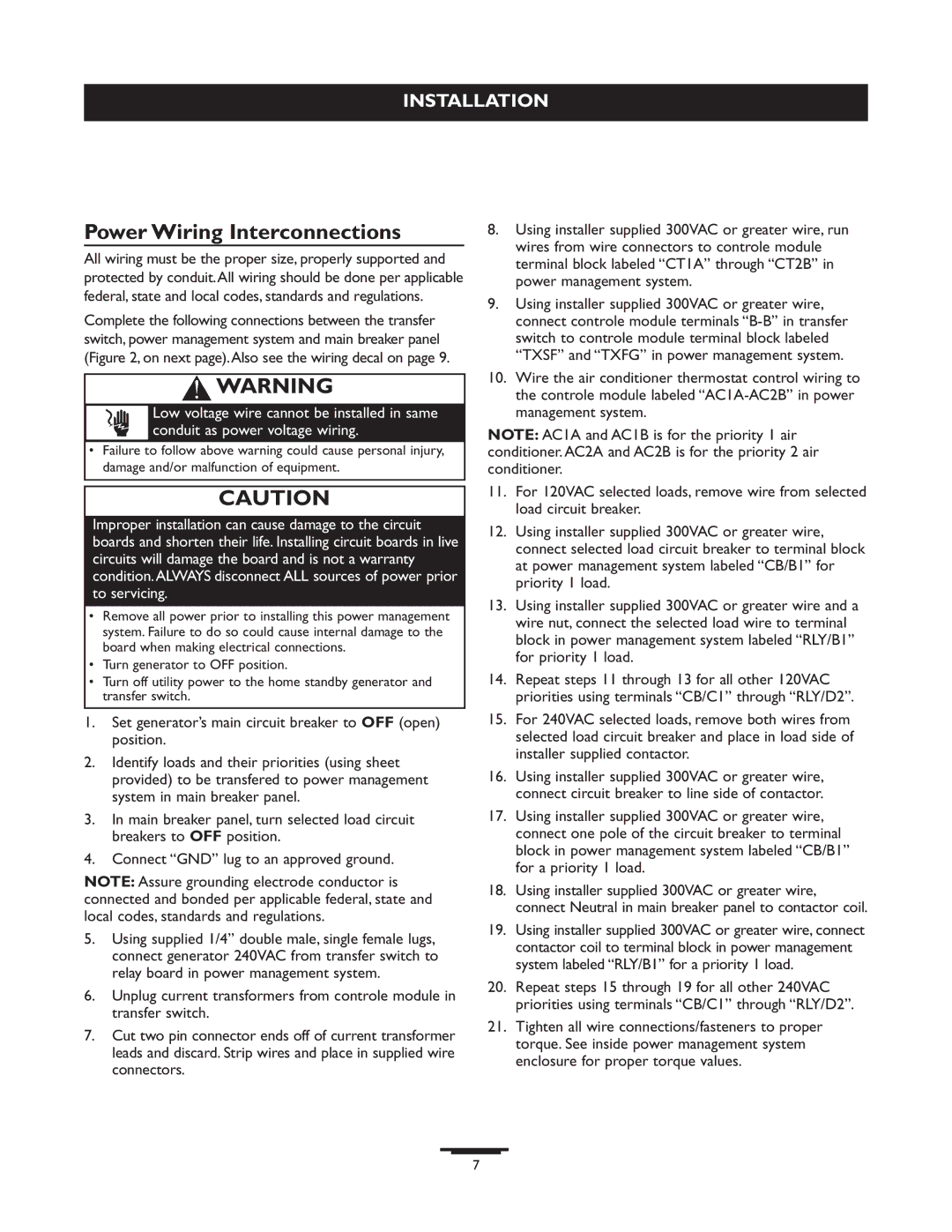
INSTALLATION
Power Wiring Interconnections
All wiring must be the proper size, properly supported and protected by conduit.All wiring should be done per applicable federal, state and local codes, standards and regulations.
Complete the following connections between the transfer switch, power management system and main breaker panel (Figure 2, on next page).Also see the wiring decal on page 9.
![]() WARNING
WARNING
Low voltage wire cannot be installed in same conduit as power voltage wiring.
•Failure to follow above warning could cause personal injury, damage and/or malfunction of equipment.
CAUTION
Improper installation can cause damage to the circuit boards and shorten their life. Installing circuit boards in live circuits will damage the board and is not a warranty condition.ALWAYS disconnect ALL sources of power prior to servicing.
•Remove all power prior to installing this power management system. Failure to do so could cause internal damage to the board when making electrical connections.
•Turn generator to OFF position.
•Turn off utility power to the home standby generator and transfer switch.
1.Set generator’s main circuit breaker to OFF (open) position.
2.Identify loads and their priorities (using sheet provided) to be transfered to power management system in main breaker panel.
3.In main breaker panel, turn selected load circuit breakers to OFF position.
4.Connect “GND” lug to an approved ground.
NOTE: Assure grounding electrode conductor is connected and bonded per applicable federal, state and local codes, standards and regulations.
5.Using supplied 1/4” double male, single female lugs, connect generator 240VAC from transfer switch to relay board in power management system.
6.Unplug current transformers from controle module in transfer switch.
7.Cut two pin connector ends off of current transformer leads and discard. Strip wires and place in supplied wire connectors.
8.Using installer supplied 300VAC or greater wire, run wires from wire connectors to controle module terminal block labeled “CT1A” through “CT2B” in power management system.
9.Using installer supplied 300VAC or greater wire, connect controle module terminals
10.Wire the air conditioner thermostat control wiring to the controle module labeled
NOTE: AC1A and AC1B is for the priority 1 air conditioner. AC2A and AC2B is for the priority 2 air conditioner.
11.For 120VAC selected loads, remove wire from selected load circuit breaker.
12.Using installer supplied 300VAC or greater wire, connect selected load circuit breaker to terminal block at power management system labeled “CB/B1” for priority 1 load.
13.Using installer supplied 300VAC or greater wire and a wire nut, connect the selected load wire to terminal block in power management system labeled “RLY/B1” for priority 1 load.
14.Repeat steps 11 through 13 for all other 120VAC priorities using terminals “CB/C1” through “RLY/D2”.
15.For 240VAC selected loads, remove both wires from selected load circuit breaker and place in load side of installer supplied contactor.
16.Using installer supplied 300VAC or greater wire, connect circuit breaker to line side of contactor.
17.Using installer supplied 300VAC or greater wire, connect one pole of the circuit breaker to terminal block in power management system labeled “CB/B1” for a priority 1 load.
18.Using installer supplied 300VAC or greater wire, connect Neutral in main breaker panel to contactor coil.
19.Using installer supplied 300VAC or greater wire, connect contactor coil to terminal block in power management system labeled “RLY/B1” for a priority 1 load.
20.Repeat steps 15 through 19 for all other 240VAC priorities using terminals “CB/C1” through “RLY/D2”.
21.Tighten all wire connections/fasteners to proper torque. See inside power management system enclosure for proper torque values.
7
